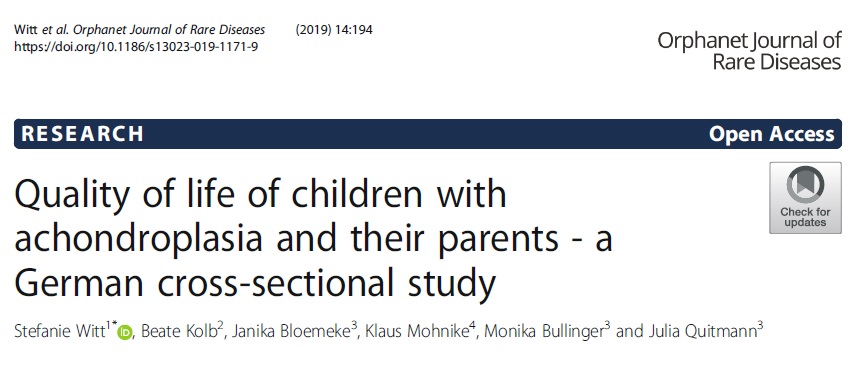Study on Quality of life of children with achondroplasia and their parents
There are some studies about the quality of life of children with chronic health conditions from both the child and parent perspective but the results are contradictory or they don’t show consistent results.
In August of 2019, it was published at the Orphanet Journal of Rare Diseases1 the study "Quality of life of children with achondroplasia and their parents - a German cross-sectional study" with the purpose to investigate the quality of life of children with achondroplasia from children and parent’s perspective as well as the parental quality of life. In this study participated a total of 73 families, including 73 parent-reports (children aged 5-14 years) and 47 child-reports (children aged 8-14 years). Families (one parent per child) were selected through the German Association for People of Short Stature and their Families2.
Children’s quality of life was assessed using the generic PedsQL 4.0™ questionnaire. This instrument is composed by four domains (Physical Functioning, Emotional Functioning, Social Functioning, and School Functioning) and three overall scores (Psychosocial Health Summary Score, Physical Health Summary Score, and Total Score). Parents quality of life was also evaluated using a Short-Form-8 questionnaire (SF-8), an internationally generic quality of life instrument.
Results
1. Parents attribute a lower quality of life to their child in all domains when compared to average height population. This fact can be explained by the physical restrictions and limitations as well as various challenges in daily life reported by children, adolescents and young adults with achondroplasia.
2. Children rated their quality of life significantly lower compared to a healthy reference population, with the exception of the emotional domain, similar to the healthy population. Emotional domain includes expressions like feelings of anxiety, sadness, anger, worry and sleep difficulties. It appears that the children may have learned to accept themselves as they are and to be satisfied with themselves, even if they experience significant limitations regarding physical, scholar and social quality of life. While these capacities and environments cannot be influenced by the children themselves, intrapersonal emotional attitude towards oneself can be modulated and strengthened by suitable coping strategies and social support from parents and friends.
3. Also, this study showed that comparing parent’s quality of life with values of a German reference population, there are no differences for the physical component score but there are significantly lower scores for the mental component score. Probably because the children with achondroplasia often suffer from many complications and achondroplasia related limitations in everyday life, which means constant concerns.
4. The higher the parental quality of life is, the higher the parent-reported children’s quality of life and the higher the children-reported quality of life! This means that the children’s quality of life can be influenced by the way that parents perceive the impact of achondroplasia in their life.
In conclusion, it’s crucial to understand that the diagnosis of achondroplasia and its consequences affects not only the child but the family as a whole because they have to adapt to the child’s special needs.
Resources:
https://www.ncbi.nlm.nih.gov/pubmed/31399110
https://www.bkmf.de/
Article summary by Inês Amaral


